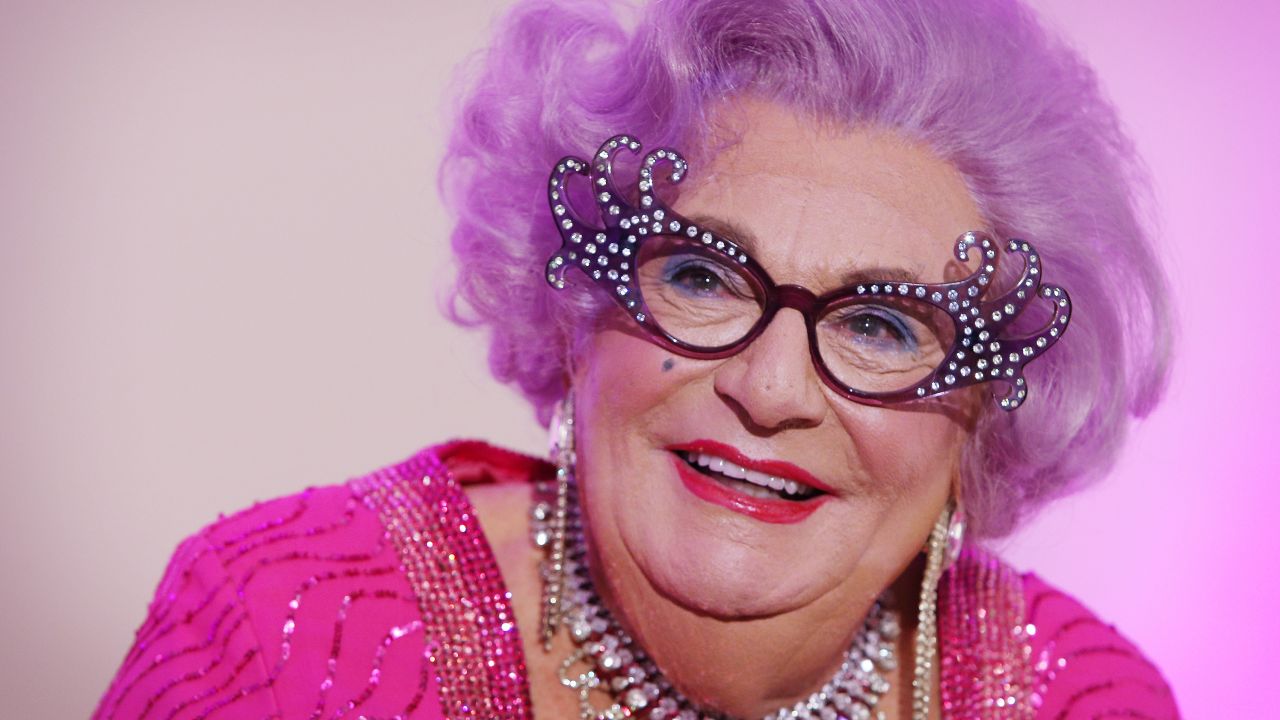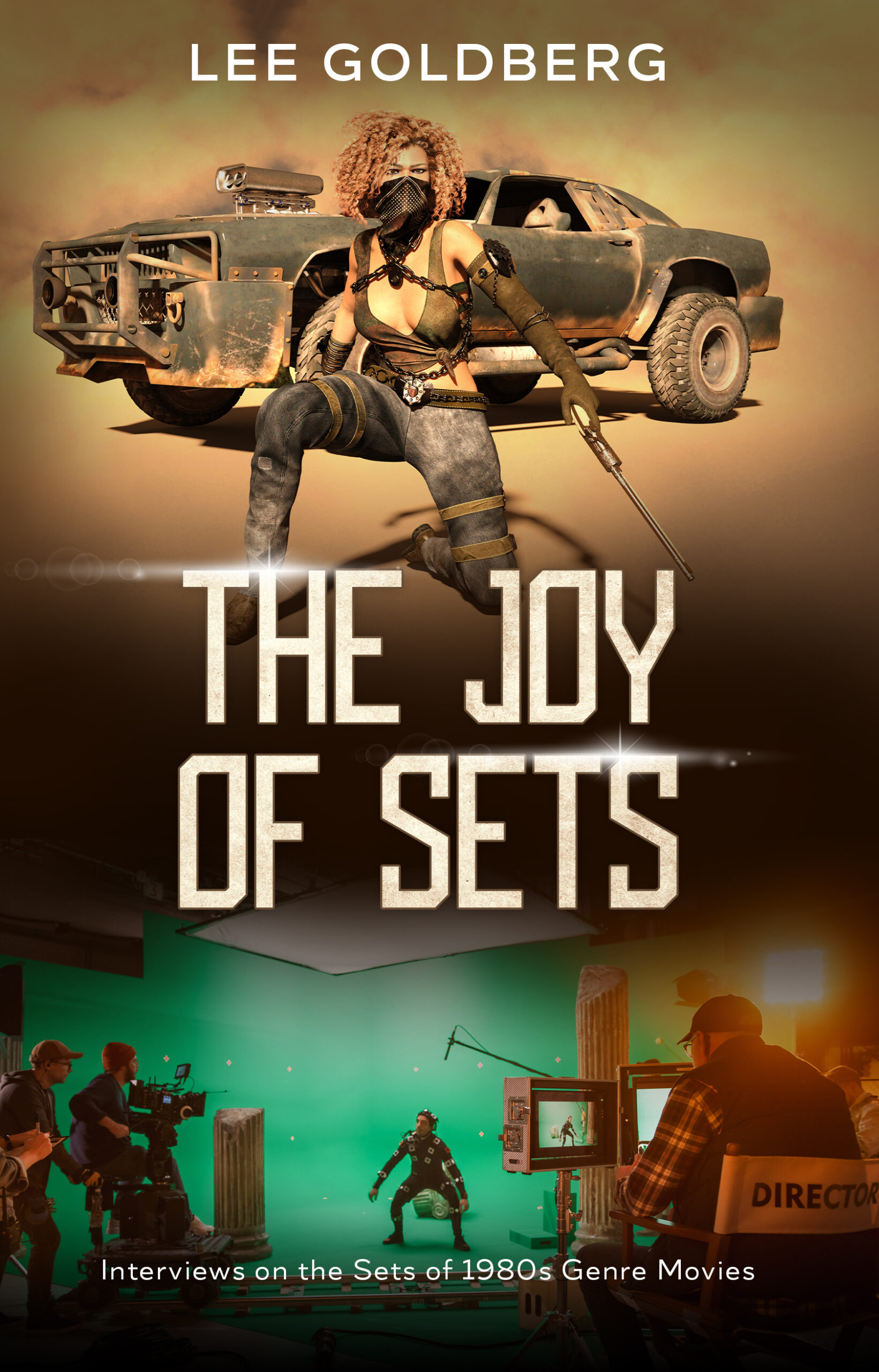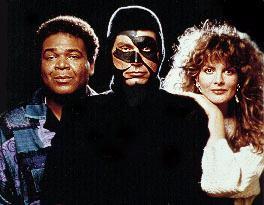The Writing Life
Dame Edna and Me
I’m sad to hear that Barry Humphries has passed away. One of the absolute highlights of my career was writing a DAME EDNA movie for him. It was initially developed for the A&E network and was meant to be the first in a series. What the network wanted was a mystery solved by Dame Edna. I got the gig because Barry had read my book Watch Me Die (then called The Man with the Iron-On Badge) and had really liked it. The opportunity was too good to pass up …and, incidentally, would also be the biggest payday I’d ever had as a screenwriter (and my first solo script without my then-writing partner Bill Rabkin).
But could I actually do it?
I watched just about everything Barry had ever done as Dame Edna, or at least everything I could get my hands on, and read all of his books, as well as John Lahr’s book about him. I was confident in my ability to write a mystery, and to be funny, but not anywhere near as funny as Dame Edna. The project scared me. How could I even try to be as funny as him? To capture his unique voice? It was insane. Moreover, so much of Dame Edna was also rooted in Australian culture, which I knew nothing about.
So when I met with Barry, in his suite at a Beverly Hills hotel, the first thing I told him was that I will never be as funny as you. If I’m lucky, I’ll get you a script that 40% of the way there joke-wise, and you’ll have to do a major pass to make it your own…to make it Dame Edna. But he shrugged that off. He had great faith in me — a lot more than I had in myself.
I worked on the outline with him and his good friend, producer Gary Hoffman, for the next several weeks. It was so much fun. I don’t think I’ve ever laughed so much developing a story. Then it came time to pitch the project to the head of A&E in person. The three of us went in. I was counting on Barry to do the pitch with me. We’d never actually talked about that — I’d assumed it was a given. Why else would Barry be coming? We needed his star power and his wit.
I started things off. When we got to the first scene where Dame Edna appears, I turned to him to take over… and he just looked at me with a smile. I didn’t know it then, but he wouldn’t do Dame Edna unless he was in the make-up and outfit. He could only talk about her in third-person…and he wouldn’t even do that.
I was on my own.
I ended up having to imitate Dame Edna in front of the man who’d created the legendary character. I was terrified and furious at the same time. It was like trying to imitate Robin Williams or Jonathan Winters in front of them. But I had no choice. I wanted to sell the project. So I pretended he wasn’t there and gave it my all. Everybody was laughing. I wasn’t sure if it was at me or with me.
It didn’t matter. The president of A&E loved the pitch and I got the greenlight to write the script. I left that meeting soaked in sweat, embarrssed and angry despite our success. But Barry couldn’t have been happier or more supportive. He told me I did great.
Barry was very easy to work with, which I honestly didn’t expect. Whenever I approached him with questions or ideas, he was always gregarious, friendly, open-minded. There were a couple of times that I called him when he happened to be preparing to go on stage as Dame Edna, or had just come off-stage. Whenever that happened, he talked to me in character, even if he was alone in his dressing room. That’s because once the wig, glasses, and outfit were on, he refused to break character (that was also why, he once told me, doing his guest role on ALLY McBEAL was incredibly exhausting for him — he was Dame Edna playing a role. So even when he was “off-camera” he was still “on-camera.” He never was able to relax. He couldn’t be himself until he got back to his hotel room and out of the make-up). Those calls with Dame Edna were hilarious, and a bit unsettling, but also very helpful. I could ask the character herself the questions I had about her. It also felt like I was getting a private Dame Edna performance… and, in essence, I was. My only regret is that I never recorded one of those calls.
Barry loved my script — and, to my shock and delight, he didn’t change a single word. So Gary turned it in to the network and we waited. The network president loved it, too. I was so excited. We all were. But then the president was unexpectedly pushed out and the new regime rethought their programming strategy…and a series of DAME EDNA movies didn’t fit in. They dropped the movie.
But Gary refused to let the project die. He was able to get the project going as a feature in the UK thanks to, if memory serves, a big tax rebate. But then, shortly before pre-production was about to begin, the rebate was pulled, the funding gap couldn’t be filled, and the project was over. I was heart-broken. There were times over the next few years when it seemed like it might come back, but it didn’t happen. The problem was that Dame Edna was big in Australia and the UK, but not big enough elsewhere to get the necessary money or presales internationally.
That was it. We all moved on.
Some years later, after my career as a novelist really took off, Gary self-published my script as an ebook on Amazon, perhaps to generate new interest in the movie. I honestly wasn’t too happy that he did that, especially because the cover was amateurish and the interior formatting was wonky, but I didn’t own the script or the character, so it was out of my hands. I never included the ebook in my bibliography nor shared its existence with anyone. The truth is, I haven’t looked at the script in at least 12 years…probably longer. But you can. The ebook version of the script is still available. I don’t know if the script holds up after all this time. You’ll have to tell me.
I lost touch with Barry after the project fizzled, but I’ve always cherished the memory of working with him, and not just for the laughter or the paycheck. The experience undoubtedly made me a better writer. Certainly a funnier one, and I’m sure whatever lessons I learned from him, a true master of comedy and character, are still shaping my work today.
The Joy of Sets
I recently released a slim little book called THE JOY OF SETS: Interviews on the Sets of 1980s Genre Movies.
Go back in time with me to the 1980s, when I was a young journalist and aspiring author, and visit the sets of movies like Back to the Future, A Nightmare on Elm Street, and A View To a Kill, where I interviewed Michael J. Fox, William Friedkin, Wes Craven, Chevy Chase, Robert Zemeckis, Roger Moore, and many others actors, directors, producers and screenwriters.
I put myself through college by writing freelance articles, primarily about movies, TV and publishing, for publications like Starlog, American Film, Cinefantastique, and the San Francisco Chronicle. I didn’t do it just to pay my tuition and support myself… I also saw it as a way to get a graduate school education in all aspects of the entertainment industry…learning lessons I’m still benefitting from today.
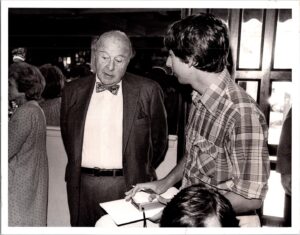
I’d go to the set of a movie and interview everyone — the actors, director, writers, special effects guys, production designers, etc. I’d write an overall “set piece,” with quotes from everybody, then longer interviews with each person that I’d sell sepately (though Starlog commissioned and published most of them).
The set pieces are a snapshot of film history, offering a revealing look at film-making in the 1980s, while also exploring the long careers of established talents like Kurt Russell and director Fred Schepsi at the top of their game…and introducing newcomers like Johnny Depp and director W.D. Richter, some of whom went on to greatness, and others who disappeared into obscurity.
I think this Bookgasm review really captures why I decided to publish this collection:
Lee Goldberg’s collection indeed captures the feeling of reading about hotly anticipated movies in the blockbuster excess of the ’80s. One can sense the then-young film obsessive had to have felt with such access to the making of multimillion-dollar pictures. While not all of these Interviews on the Sets of 1980s Genre Movies (as the subtitle has it) entail movies worth watching, Goldberg’s reports never fail to entertain. As with his recent James Bond Films volume, one reason is revisiting a once-dominant type of film journalism; the larger is the in-hindsight delight of checking how forecasts panned out.
I hope you enjoy it!
Disney Must Pay
I am a member of the #DisneyMustPay Joint Task Force, a group of various writers’ organizations (SFWA, MWA, ITW, etc), that is demanding that authors, comic book & graphic novel creators get paid the royalties they’ve earned for their work from Disney & its companies. Here’s the full press release:
LOS ANGELES (August 12, 2021) – The #DisneyMustPay Joint Task Force is expanding its focus and reaching out to all comic book and graphic novel creators who may be missing royalty statements and payments from Disney and its companies.
“Writers, artists, illustrators, letterers, and other artists are valued members of the creative teams that produce art and literature that is enjoyed by millions,” said Mary Robinette Kowal, Task Force Chair. “We are inviting these talented artists to share their stories and we will fight for them to receive the money that is owed to them.”
All potentially affected writers and artists should contact the Task Force to share their stories. Creators who are missing royalties or royalty statements may fill out this form hosted by SFWA. Anonymity is guaranteed.
Lee Goldberg, Task Force member and founder of the International Association of Media Tie-In Writers (IAMTW), adds his thoughts about the need for the #DisneyMustPay Task Force to expand its reach to all creators: “Novelists and illustrators provide a rich, all-encompassing story-telling experience, their words creating fully flesh-out characters and detailed images, if not entire worlds and universes, in the readers’ minds. The authors and artists honored their obligation to write and create their books. Now Disney should have the decency and integrity to honor their obligation to pay them. It’s that simple.”
Sandra Wong, National President of Sisters in Crime, states, “Sisters in Crime believes that writers and creators should be paid what they’re legally owed for their work, no matter the media or genre. We joined the Task Force to help spread the word to potentially affected authors, since Disney has placed the onus to be paid on writers and creators, and to lend our voice to an issue which has potential consequences for all creators.”
The Task Force’s goals are to ensure that all writers and creators who are owed royalties and/or statements for their media-tie in work are identified and that Disney and other companies honor their contractual obligations to those writers and creators after acquiring the companies that originally hired them.
Fans, fellow writers, and the creative community need to continue to post on social media showing their support so the #DisneyMustPay Joint Task Force can help writers. Thanks to their support, the message is reaching Disney and related organizations, to alert them to the work they need to do to honor their contractual obligations.
Progress has been made, most notably ensuring that three well-known media tie-in authors have been paid and attaining the cooperation of BOOM! Studios in identifying affected authors. However, more than a dozen additional authors are still in negotiations with Disney. Many of them, especially ones with lesser-known names, find communications with Disney repeatedly stalled until pressure is again applied by the Task Force and its supporters.
The #DisneyMustPay Joint Task Force, formed by SFWA, includes the Authors Guild, Horror Writers Association, International Association of Media Tie-In Writers (IAMTW), International Thriller Writers, Mystery Writers of America, National Writers Union, Novelists, Inc., Romance Writers of America, and Sisters in Crime (SinC). Individual writers on the Task Force include Neil Gaiman, Lee Goldberg, Mary Robinette Kowal, Chuck Wendig, and Tess Garritsen. The Task Force identifies and guides authors and creators who might be owed money. Disney is refusing to cooperate with the task force to identify affected authors.
The #DisneyMustPay Joint Task Force is working to make sure creators’ contracts are honored, but individual negotiations are rightly between the creators, their agents, and the rights holder. The Disney Task Force is working to address structural and systemic concerns.
Additional updates and information are available at www.writersmustbepaid.org.
Work-For-Hire Conundrum
According to multiple sources, when a writer or artist’s work features prominently in a Marvel film, the company’s practice is to send the creator an invitation to the premiere and a cheque for $5,000 (£3,600). Three different sources confirmed this amount to the Guardian. There’s no obligation to attend the premiere, or to use the $5,000 for travel or accommodation; sources described it as a tacit acknowledgment that compensation was due.
Marvel declined to comment on this, citing privacy concerns. “We can’t speak to our individual agreements or contracts with talent,” said a spokesman.
Several sources who have worked with Marvel say that remuneration for contributing to a franchise that hits it big varies between the $5,000 payment, nothing, or – very rarely – a “special character contract”, which allows a select few creators to claim renumeration when their characters or stories are used. There are other potential ways to earn more – many former writers and artists are made executives and producers on Marvel’s myriad movies, cartoons and streaming series, for example – but those deals depend on factors other than legal obligation.
“I’ve been offered a [special character contract] that was really, really terrible, but it was that or nothing,” says one Marvel creator, who asked not to be named. “And then instead of honouring it, they send a thank you note and are like, ‘Here’s some money we don’t owe you!’ and it’s five grand. And you’re like, ‘The movie made a billion dollars.’”
The way Marvel writers & artists are being treated may be “contractually legal,” but it is still despicable.
I’m very, very lucky. I have been treated fairly in my work-for-hire deals, which include my Monk and Diagnosis Murder novels. Those were great experiences. But I was in a unique position in both cases.
On Diagnosis Murder, I was the executive producer/showrunner on the TV series for several years (all with William Rabkin). The publisher and studio came to me to write the books… and that gave me leverage. Creatively, I certainly wasn’t going to let them tell me how to write books based on a TV series that I exec-produced. And, to their credit, they never dared 🙂 I had complete creative freedom.
On Monk, I was already a writer on the TV show and good friends with Andy Breckman, the creator/showrunner. He gave me free reign to do as I pleased creatively and he personally made sure I was treated fairly on every level (and two of my books were adapted into episodes). I wish I was paid a lot more, but otherwise, I look back on those 15 books with nothing but fondness.
The big pitfall with work-for-hire book deals is that you don’t own any aspect of your work. It’s the equivalent of building an addition on someone else’s home. In most work-for-hire deals, you are paid a one-time flat fee, a buy-out of all rights and royalties. Some work-for-hire deals, like mine, included a share of royalties and can also include a share of some future rights, like a movie or TV adaptation, but that’s very rare and few authors have the leverage to demand it…and get it.
The common work-for-hire, total buyout deal is easier to stomach when you are working within a hugely successful intellectual property you didn’t create… and it can bring your work (and your name) to a wider audience than you could ever hope to reach on your own, especially early in your career. It can be a big boost in visibility (reviews, bestseller lists etc) that’s worth the often very low pay, draconian deadlines, and rigid creative restrictions.
But a work-for-hire deal becomes thornier when you create new characters and storylines that lead to other works in the “universe” you are working it. Take, for example, the freelance TV writer who wrote the “Space Seed” episode of the original Star Trek series. Decades later, the character he created became the basis for Star Trek II: The Wrath of Khan. My guess is that he got paid a pittance, if anything, and no credit. The Writers Guild of America has since dramatically increased protections (and compensation and credit) for writers in that situation, but authors don’t have a union in their corner or anything close to the same protections. They have an agent, or a lawyer, and they can consult with the Authors Guild (which has no teeth and is not a union), but they are still likely to get screwed over. The $10,000 you got paid to write a work-for-hire book seems like a win at the time…but it becomes an insult if the novel is later adapted into a movie or TV series or TV series episode…and you not only don’t paid anything more, you don’t even get a credit for your work.
Work-for-hire contracts in the publishing world are routinely slanted against the writer on every level. That needs to change. But will it? I doubt it.
The Mail I Get: Rejection Edition
 How to never sell your book…
How to never sell your book…
We received a submission at Brash Books, the small publishing company I co-founded six years ago with Joel Goldman. After reading the submission, we decided to pass. This is the entirety of the rejection letter we wrote to the author:
Thank you for thinking of Brash for XYZ. Unfortunately, it’s not a fit for us. We wish you the very best finding the right home for the book.
His reply:
Keep printing The same redundant shit Arrogant ass, just remember the title of this book, u will see it on the best sellers list asshole.
And I’m sure he wonders why he hasn’t sold a book yet. (BTW, his submission was awful). So I decided to respond:
I sincerely doubt it… and I say that as a novelist who has actually been at the top of the New York Times, USA Today, Wall Street Journal, and Washington Post bestseller lists multiple times. To be a successful author, you not only need to write well, and tell a good story… you also need to have some decent people skills. If I lashed out and called every publisher who politely rejected my work an arrogant asshole, I wouldn’t have achieved my success. How do I know? Because I ultimately ended being published by two of the publishers who’d rejected my previous work. You are clearly the biggest obstacle to your success. You might want to rethink your strategy.
He responded a short time later.
This book has a very complex plot and vivid characterization that you couldn’t have possibly ascertain in the brief time you review my story. is a very complex plot, and profound characterization. This story is very unique, and has major shocking twists at the end! A PHD from Western Kentucky, who was a professor for 38 years is editing it, and compared it to Silence of the Lambs. It is very, very unique story, and intertwines orwellian themes, which compare to today’s political and social upheaval. I DO APOLOGIZE FOR LASHING OUT, NOT PROFESSIONAL AT ALL, sorry just have my heart and soul in this book, and you rejected it in record time, this is not my first rodeo, again I do apologize!
Still a little crazy, but at least he apologized. I guess that’s progress.
Sweet Home Alabama
I had a great time as a guest of honor at two conferences in Alabama last weekend — Murder in Magic City in Birmingham and Murder on the Menu in Wetumpka. But things got off to an embarrassing start.
I arrived in Birmingham airport late on Friday. The volunteer who was picking me up texted me a message as I got off the plane — “I’m the blond in the blue Honda Pilot parked outside of baggage claim.”
So I stepped outside, spotted the blond in the Honda Pilot, knocked on the window, opened the back door, tossed my luggage on the seat and climbed in.
We drove a couple of yards and she glanced at me in her rearview and said “Are you John Ballard?”
“No, I’m Lee Goldberg.”
“Then what the hell are you doing in my car?”
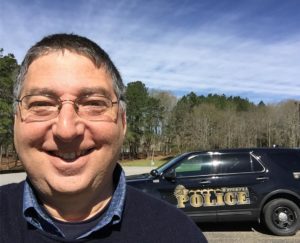
“You’re a blond in a Honda Pilot parked at baggage claim.”
She came to a hard stop. I began to explain when another, identical blue Honda Pilot with a blond at the wheel drives up.
I said, “Oops, wrong blond.”
I apologized, grabbed my luggage, and hopped out. I felt like an oaf…but at least she saw that it was a genuine mistake.
Things went more smoothly after that, I am pleased to say. I joined Sue Ann Jaffarian (who arrived in her new RV), Matt Coyle, Stacy Allen, Hank Early, Carrie Smith, JD Allen, Emily Carpenter, Christopher Swann, Toni Kelner, and many other authors to discuss mysteries, the business of writing, and our journeys into print. The first conference was held at a library in Birmingham and we stayed at a hotel that had a free soft drink dispenser in the lobby. Free-flowing Diet Coke. That’s a perk I could get used to.
On Sunday, we were taken an hour or so away to Wetumpka, an adorable little town on a river that was nearly wiped off the map by a tornado a few months ago. We were greeted warmly by the Mayor, given our own library cards by the library staff, and then went out to speak to an enthusiastic audience.
I had a great time. That said, during the signing, a reader caught me off guard with this comment:
“I keep falling asleep while reading the first chapter of your book so I jumped to the last chapter & it put me to sleep too… but I’m not giving up on you.”
I told her I appreciated her faith in me…
S is for Sad
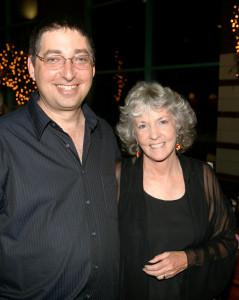
I’m so sad to hear about Sue Grafton‘s death. Not only was she incredibly talented, she was also a very nice woman.
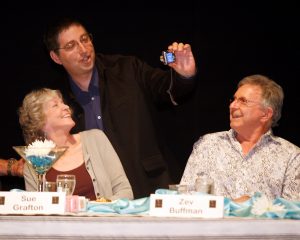
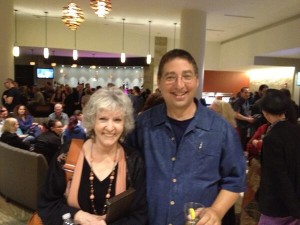

Cheesecake
Here’s the main title sequence for SABLE, an awful series that only lasted for a month in 1988. William Rabkin & I wrote an awful freelance script for this awful series that thankfully wasn’t shot — but it had a lasting impact on us.
The show had a terrible, expository character, an African-American tech wizard in a wheelchair, named Cheesecake. We hated that character…because it wasn’t a character. It was a painful cliche. So “Cheesecake” became our shorthand, and is to this day, for a cliche character who exists only to provide dull exposition.
It’s amazing and depressing how many times that EXACT SAME DREADFUL CHARACTER — the exposition/computer whiz character in a wheelchair — has been repeated in shows since then.
Cheesecake came to mind today because I just watched the first regular episode of Bill Bixby’s THE MAGICIAN, from the newly released DVD boxed set, that had that same “Cheesecake ” expository character — though it was a white guy in a wheelchair and aired several years before SABLE premiered. Just goes to show how long that dreadful, lazy writer cliche has existed.
Our Worst Script
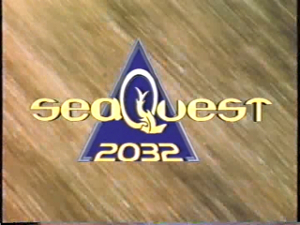 Here’s an excerpt from “About Face,” the worst script that William Rabkin and I ever wrote…but before I share it with you, here’s the story behind it (which I originally shared on this blog back in July 2006)
Here’s an excerpt from “About Face,” the worst script that William Rabkin and I ever wrote…but before I share it with you, here’s the story behind it (which I originally shared on this blog back in July 2006)
We were working as supervising producers on the third season of SeaQuest, a scifi show about a phallic submarine exploring our oceans in the year 2032. We were a day into writing episode 14 when the series got cancelled. But studio and the network were still obligated to pay us for the script — the catch was that we actually had to write it if we wanted our money.
In other words, we had to write a script we knew would never be shot and that we were pretty certain nobody would ever read. But we weren’t about to walk away from $25,000.
So we wrote it in one day…while we were packing up our office. We amused ourselves by writing the worst scenes that we possibly could, reading them out loud to each other as we wrote. We turned in the script as we walked out the door and we assumed it would never be read.
To our horror, we were wrong.
We discovered years later that bootleg copies of this atrocity were showing up at science fiction conventions as one of the “lost episodes” of the final season. Some have even shown up on the Internet. It even became the basis for a fanfic story.
Okay, now here’s the excerpt. All you need to know to follow along is that Piccolo is a man with gills and Darwin is a talking dolphin (I’m not kidding).
EXT. SEAQUEST – CGI/STOCK
as it cruises through the sea.
INT. SEAQUEST – CAFETERIA
Lucas is at a table eating as Piccolo comes in.
PICCOLO
Hey, Lucas, what’s the blue plate special today? I’m starving.
LUCAS
Grilled trout.
PICCOLO
Nothing else?
LUCAS
Scrod casserole.
PICCOLO
Pass.
LUCAS
Wait – I thought you were starving.
PICCOLO
I just lost my appetite.
(re: Lucas’ plate:)
You’d think the Chef could be a bit more sensitive.
LUCAS
The presentation may not be great, but it tastes pretty good.
He holds out a fork of trout.
LUCAS
Here, have a bite.
Piccolo turns away, disgusted.
PICCOLO
Are you nuts? Why don’t you go offer Darwin some dolphin pate.
Suddenly Lucas understands.
LUCAS
Tony, you aren’t a fish.
PICCOLO
I have gills, Lucas. I may not be a fish, but it still feels like
cannibalism to me.
LUCAS
You’re a human being who happens to have gills, that’s different.
PICCOLO
If you could fly, believe me, chicken wouldn’t look very
appetizing.
LUCAS
Chickens don’t fly.
Piccolo glares at Lucas and walks out. Lucas smiles to himself.

